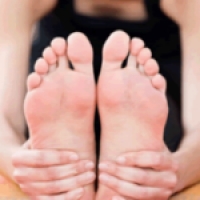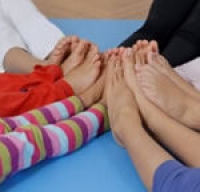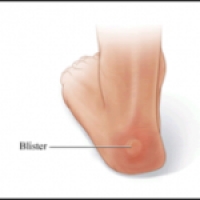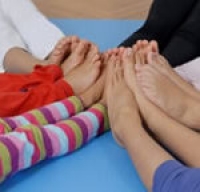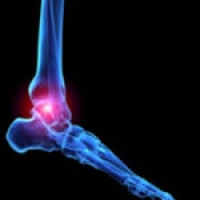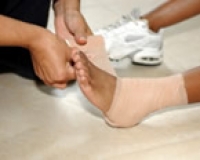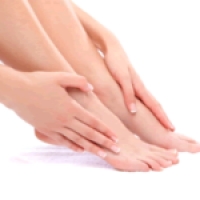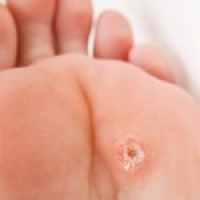
Blog (729)
How to Prevent Ingrown Toenails
Ingrown toenails occur when “the nail plate edge digs into the adjacent nail fold (soft tissue around the border of a nail),” leading to symptoms of inflammation and even infection. Avoid wearing shoes that are too tight that can put pressure on the nails, and avoid trimming your nails improperly. If your toenails are prone to curving or becoming brittle, this can also lead to an ingrown toenail. Treating your ingrown toenails involves gently filing the nail edge away from your skin after soaking your toe in warm water.
Ingrown toenails can become painful if they are not treated properly. For more information about ingrown toenails, contact Dr. Kenneth Donovan from Advanced Care Foot and Ankle. Our doctor will answer any of your foot- and ankle-related questions.
Ingrown Toenails
Ingrown toenails occur when a toenail grows sideways into the bed of the nail, causing pain, swelling, and possibly infection.
Causes
- Bacterial infections
- Improper nail cutting such as cutting it too short or not straight across
- Trauma to the toe, such as stubbing, which causes the nail to grow back irregularly
- Ill-fitting shoes that bunch the toes too close together
- Genetic predisposition
Prevention
Because ingrown toenails are not something found outside of shoe-wearing cultures, going barefoot as often as possible will decrease the likeliness of developing ingrown toenails. Wearing proper fitting shoes and using proper cutting techniques will also help decrease your risk of developing ingrown toenails.
Treatment
Ingrown toenails are a very treatable foot condition. In minor cases, soaking the affected area in salt or antibacterial soaps will not only help with the ingrown nail itself, but also help prevent any infections from occurring. In more severe cases, surgery is an option. In either case, speaking to your podiatrist about this condition will help you get a better understanding of specific treatment options that are right for you.
If you have any questions please feel free to contact one of our offices located in Warren, Livingston, and Toms River, NJ. We offer the newest diagnostic and treatment technologies for all your foot and ankle needs.
Tips for Comfortable Feet
Aching feet can be very troublesome and distracting while on the job. Fortunately, there are some tips you can use to make your feet more comfortable. The first tip is to buy your shoes in the afternoon, because that is when feet swell the most. There should be about one centimeter of space between your longest toe and the end of the shoe. Another tip is to make sure your feet are moisturized. However, you should avoid putting moisturizer between your toes, because that may lead to athlete’s foot. Lastly, you should not ignore pain in your feet. If you are experiencing a constant pain that will not go away, you should go see a podiatrist for help.
Every day foot care is very important to prevent infection and other foot ailments. If you need your feet checked, contact Dr. Kenneth Donovan from Advanced Care Foot and Ankle can provide the care you need to keep you pain-free and on your feet.
Every Day Foot Care
Often, people take care of their bodies, face and hair more so than they do for their feet. But the feet are a very important aspect of our bodies, and one that we should pay more attention to. After all, without our feet, we would not be able to perform most daily tasks. It is best to check your feet regularly to make sure there are no new bruises or cuts that you may not have noticed before, for example.
For dry feet, moisturizer can easily be a remedy and can be applied as often as necessary to the affected areas. Wearing shoes that fit well can also help you maintain good foot health, as well as making it easier to walk and do daily activities without the stress or pain of ill-fitting shoes, high heels, or even flip flops.
Also, wearing clean socks with closed shoes is important to ensure that sweat and bacteria do not accumulate within the shoe. Clean socks help to prevent athlete’s foot, fungi problems, bad odors, and can absorb sweat.
If you have any questions please feel free to contact one of our offices located in Warren, Livingston, and Toms River, NJ. We offer the newest diagnostic and treatment technologies for all your foot and ankle needs.
A New Bunion Treatment
A new procedure for bunion treatment involves a less traumatic process of creating incisions and shaving down the bone that forms the bunion, a safer and less painful alternative to traditional bunion surgery. The standard bunion surgery involves breaking a toe bone and inserting pins. Recovery time for the new procedure is less, ranging about a week, allowing patients to quickly resume their lives post-treatment.
Untreated bunions can make walking uncomfortable. If you are suffering from bunions, contact Dr. Kenneth Donovan from Advanced Care Foot and Ankle will attend to all of your foot and ankle needs and answer any of your related questions.
What is a Bunion?
A bunion is formed of swollen tissue or an enlargement of boney growth, usually located at the base joint of the toe that connects to the foot. The swelling occurs by the bones in the big toe shifting inward, which impacts the other toes of the foot. This causes the area around the base of the big toe to become inflamed and painful.
Why do Bunions Form?
- Genetics – susceptibility to bunions are often hereditary
- Stress on the feet – poorly fitted and uncomfortable footwear that places stress on feet, such as heels, can cause bunions to form
How are Bunions Diagnosed?
Doctors often perform two tests – blood tests and x-rays – when trying to diagnose bunions, especially in the early stages of development. Blood tests help determine if the foot pain is being caused by something else, such as arthritis, while x-rays provide a clear picture of your bone structure to your doctor.
How are Bunions Treated?
- Refrain from wearing heels or similar shoes that cause discomfort
- Select wider shoes that can provide more comfort and reduce pain
- Anti-inflammatory and pain management drugs
- Orthotics or foot inserts
- Surgery
If you have any questions, please feel free to contact our office located in Warren, Livingston, and Toms River, NJ. We offer the newest diagnostic and treatment technologies for all your foot care needs.
DIY Pedicures
Pedicures are very important when it comes to maintaining healthy feet. Prior to giving yourself a pedicure, you should soak your feet in hot water with bath salts or oils. Soaking your feet will help soften calluses and remove any unwanted particles from your skin. The next step in your DIY pedicure is to trim your toenails. Trimming your toenails will help prevent dirt from being trapped underneath them. You should be careful to cut straight across when trimming your nails, in order to prevent ingrown toenails. Be sure to file your nails in the same direction in order to avoid damaging your nails.
Every day foot care is very important to prevent infection and other foot ailments. If you need your feet checked contact Dr. Kenneth Donovan from Advanced Care Foot and Ankle. Our doctor can provide the care you need to keep your pain free and on your feet.
Every Day Foot Care
Often, people take care of their bodies, face and hair more so than they do for their feet. But the feet are a very important aspect of our bodies, and one that we should pay more attention to. After all, without our feet, we would not be able to perform most daily tasks. It is best to check your feet regularly to make sure there are no new bruises or cuts that you may not have noticed before, for example.
For dry feet, moisturizer can easily be a remedy and can be applied as often as necessary to the affected areas. Wearing shoes that fit well can also help you maintain good foot health, as well as making it easier to walk and do daily activities without the stress or pain of ill-fitting shoes, high heels, or even flip flops.
Also, wearing clean socks with closed shoes is important to ensure that sweat and bacteria do not accumulate within the shoe. Clean socks help to prevent athlete’s foot, fungi problems, bad odors, and can absorb sweat.
If you have any questions please feel free to contact one of our offices located in Warren, Livingston, and Toms River, NJ. We offer the newest diagnostic and treatment technologies for all your foot and ankle needs.
Arthritis and Foot Pain
Approximately one fourth of American adults have foot pain.For those who have arthritis, their chances of suffering from foot pain increases. Fifty percent of Americans over the age of 65 suffer from arthritic foot pain. There are different types of arthritis that a person could have.. Rheumatoid Arthritis is a common form that can affect the small joints of the feet. People with the condition often develop corns, bunions, and hammertoe.
Arthritis can be a difficult condition to live with. If you are seeking treatment, contact Dr. Kenneth Donovan from Advanced Care Foot and Ankle. Our doctor can provide the care you need to keep you pain-free and on your feet.
Arthritic Foot Care
Arthritis is a joint disorder that involves inflammation of different joints in your body, such as in your feet. Arthritis is often caused by a degenerative joint disease and causes mild to severe pain in all affected areas. On top of this, swelling and stiffness in the affected joints can also be a common symptom of arthritis.
In many cases, wearing ill-fitting shoes can worsen the effects and pain of arthritis. Wearing shoes that have a lower heel and extra room can help your feet feel more comfortable. In cases of rheumatoid arthritis, the arch in your foot may become problematic. Buying shoes with proper arch support that contour to your feet can help immensely.
Alleviating Arthritic Pain
- Exercises that stretch the foot can prevent further pain and injury and increase mobility
- Most of the pain can be alleviated with anti-inflammatory drugs, heat, and topical medications
- Massages can help to temporarily alleviate pain.
It is best to see your doctor for the treatment that is right for your needs and symptoms. Conditions vary, and a podiatrist can help you determine the right method of care for your feet.
If you have any questions please feel free to contact one of our offices located in Warren, Livingston, and Toms River, NJ. We offer the newest diagnostic and treatment technologies for all your foot and ankle needs.
Pregnancy May Have an Impact on Feet
With pregnancy comes the expectation that our bodies will change in different ways, one of them being that our feet swell up. As our feet can grow in size, this means that our shoe sizes may increase as well. Make sure to accommodate your feet during pregnancy, especially since the increase in foot size may become permanent. However, expert Jessica Shepherd, M.D., says that the increase in size “usually goes away within six months to a year postpartum.”
Pregnant women with swollen feet can be treated with a variety of different methods that are readily available. For more information about other cures for swollen feet during pregnancy, consult with Dr. Kenneth Donovan from Advanced Care Foot and Ankle. Our doctor will attend to all of your foot and ankle needs.
What foot problems can arise during pregnancy?
One problem that can occur is over-pronation, which occurs when the arch of the foot flattens and tends to roll inward. This can cause pain and discomfort in your heels while you’re walking or even just standing up, trying to support your baby.
Another problem is edema, or swelling in the extremities. This often affects the feet during pregnancy, but tends to occur in the later stages.
How can I keep my feet healthy during pregnancy?
- Wearing orthotics can provide extra support for the feet and help distribute weight evenly
- Minimize the amount of time spent walking barefoot
- Wear shoes with good arch support
- Wear shoes that allow for good circulation to the feet
- Elevate feet if you experience swelling
- Massage your feet
- Get regular, light exercise, such as walking, to promote blood circulation to the feet
If you have any questions please feel free to contact one of our offices located in Warren, Livingston, and Toms River, NJ. We offer the newest diagnostic and treatment technologies for all your foot and ankle needs.
Ankle Sprains Require Treatment
Approximately 28,000 people sprain their ankle in the United States each day. About 55% of those people who sprain their ankle never go to a doctor to seek treatment for their injury. Consequently, a lot of these untreated ankle sprains will recur in the future because they haven’t been properly treated. Ankle sprains tend to be most common among active people, but they can also be caused by walking on uneven surfaces or tripping on a flight of stairs. It is very important to not ignore an ankle sprain, because it could be a much more serious injury than you expect.
Ankle sprains are common, but need immediate attention. If you need your feet checked, contact Dr. Kenneth Donovan from Advanced Care Foot and Ankle. Our doctor will assist you with all of your foot and ankle needs.
How Does an Ankle Sprain Occur?
Ankle sprains take place when the ligaments in your ankle are torn or stretched beyond their limits. There are multiple ways that the ankle can become injured, including twisting or rolling over onto your ankle, putting undue stress on it, or causing trauma to the ankle itself.
What are the Symptoms?
- Mild to moderate bruising
- Limited mobility
- Swelling
- Discoloration of the skin (depending on severity)
Preventing a Sprain
- Wearing appropriate shoes for the occasion
- Stretching before exercises and sports
- Knowing your limits can aid in prevention
Treatment of a Sprain
Treatment of a sprain depends on the severity. Many times, people are told to rest and remain off their feet completely, while others are given an air cast. If the sprain is very severe, surgery may be required.
If you have suffered an ankle sprain previously, you may want to consider additional support such as a brace and regular exercises to strengthen the ankle.
If you have any questions please feel free to contact one of our offices located in Warren, Livingston, and Toms River, NJ. We offer the newest diagnostic and treatment technologies for all your foot and ankle needs.
Changes you made may not be saved.
The American Podiatric Medical Association recently published a study revealing that much of this nation’s foot pain goes untreated. In a survey of 1,000 people over the age of 18, 77% reported experiencing foot pain, but only a third of those claim they would see a podiatrist. Half of the participants with foot pain say that the pain has hindered walking, exercising, playing with grandchildren, and other daily activities.
Among the group who sought podiatric help, 88% reported a quick diagnosis and 76% received treatment that eliminated the problem. A third of the group said that their visits to the podiatrist exposed other health concerns, such as diabetes, circulatory issues, and nerve issues.
“It’s not surprising to see how many people are affected by foot pain, when survey results show that we view our feet as the least important body part in terms of our overall health and wellbeing,” said AMPA President Frank Spinosa. “Our feet are literally and figuratively the furthest things from our minds.”
If you are experiencing pain in the feet or ankles, don’t join the stubborn majority refusing treatment. Feel free to contact Dr. Kenneth Donovan from Advanced Care Foot and Ankle. Our doctor can provide the care you need to keep you pain-free and on your feet.
What is a Podiatrist?
Someone would seek care of a podiatrist when they have suffered a foot injury or have common foot ailments such as: heal spurs, bunions, arch problems, deformities, ingrown toenails, corns, foot and ankle problems etc.
Podiatric Treatment
A podiatrist will treat the problematic areas of the feet, ankle or lower leg by prescribing the following:
- physical therapy
- drugs
- perform surgery on lower extremity fractures
- orthotic inserts or soles
A common podiatric procedure a podiatrist will use is a scanner or force plate which will allow the podiatrist to know the designs of orthotics. Patients are then told to follow a series of tasks to complete the treatment. The computer will scan the foot a see which areas show weight distribution and pressure points. The podiatrist will read the analysis and then determine which treatment plans are available.
If you have any questions please feel free to contact one of our offices located in Warren, Livingston, and Toms River, NJ. We offer the newest diagnostic and treatment technologies for all your foot and ankle needs.
Plantar Warts
Warts are viral infections of the skin cells. Specifically there are caused by the Human Papillomavirus (HPV).
There are over 100 different types of HPV, with about a dozen that cause viral infections of the foot.There are a combination of factors that cause a patient to develop plantar’s wart. First is genetics. A certain percentage of the population is genetically predisposed to being susceptible to wart. Just like some people are more prone to acne (a bacterial skin infection). some people are more prone to getting warts. This is why in certain wart prone environments (like gym mats, communal swimming pools and showers), some people develop warts while others do not.
The second cause of developing warts is weakness in the skin on the bottom of the foot. The virus needs a point of entry in order to start an infection. Dry cracked skin or overly sweaty, moisture laden skin can cause weakness, leading to viral infections caused by the HPV virus. Another common point of entry is walking barefoot and stepping on a sharp rock or stick. Even if the injury doesn’t draw blood, that little poke can cause a microscopic skin injury, leading to plantar wart formation.
Treatments for warts are extremely varied, ranging from medication you can take orally, to applying duct tape. In general, most wart treatments cause the creation of a localized immune response, so the body can fight the infection. In my office, we use Cantharone to get rid of warts. The success rate with this treatment is 99%. The treatment involves a painless application of the medicine to the affected area. Patients usually need 2-3 applications of the medicine to obtain complete healing.
